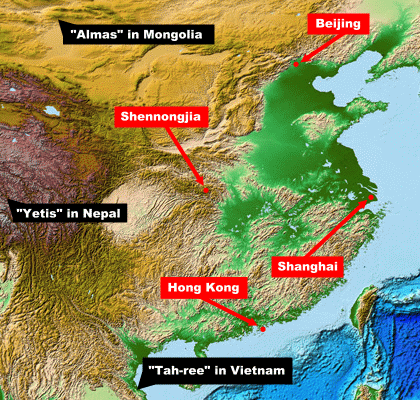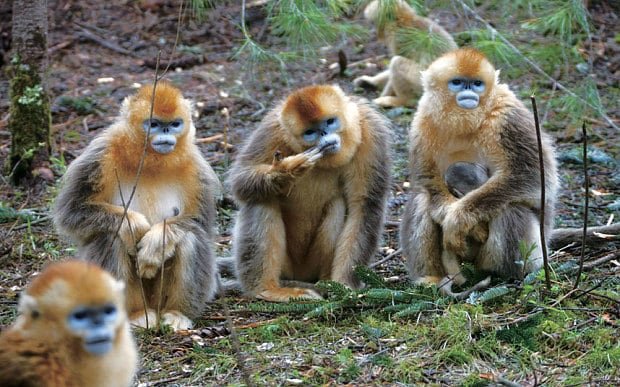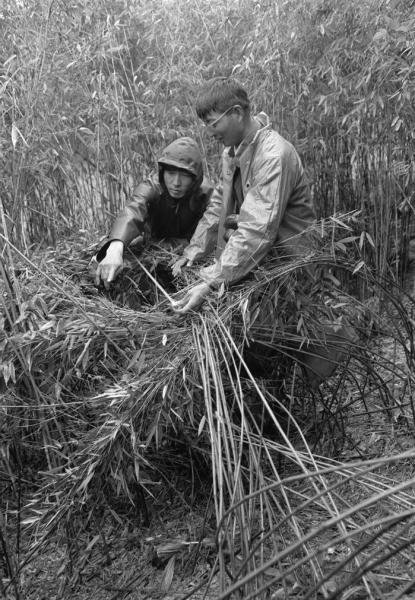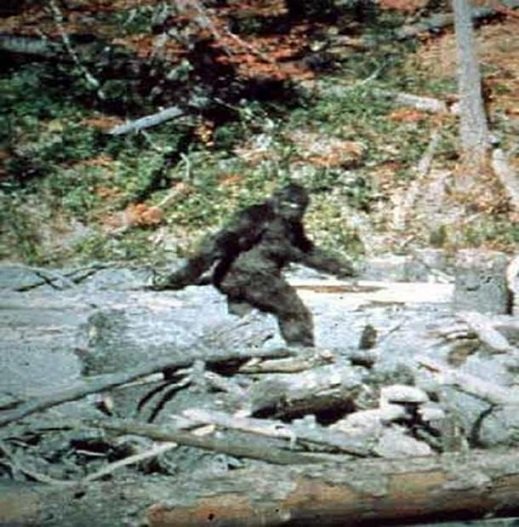10,000 Years of Strangeness: A Paranormal Primer for Ancient and Modern China
Part III: Mysteries and Legends
Chapter 14: The Yeren: the Bigfoot of China—神农架野人
Chapter 14: The Yeren: the Bigfoot of China—神农架野人

Previous Chapters 前章: Part 1: Chapter 1, Ch 2, Ch 3, Ch 4, Ch 5-1, Ch 5-2, Ch 5-3, Ch. 6
Previous Chapters 前章: Part 2: Chapter 7, Ch 8-1, Ch 8-2, Ch 8-3, Ch 8-4, Ch 8-5, Ch 9, Ch 9a
Previous Chapters 前章: Part 3: Chapter 10, Ch. 11-1, Ch. 11-2, Ch. 12, Ch. 13
Previous Chapters 前章: Part 3: Chapter 10, Ch. 11-1, Ch. 11-2, Ch. 12, Ch. 13
The yeren (野人, literally “Wildman”) may be the oldest documented mysterious creature on Earth, especially concerning something that potentially has some basis in physical reality. I detest the term “cryptid” in referring to these mysterious creatures. “Cryptid” is a pseudo-scientific term invented by so-called cryptozoologists to create a pretense of legitimacy to their work. Not that their work is illegitimate in all cases, but the pretense is unnecessary and the term “cryptid” flies in the face of scientific nomenclature.
The –id suffix is used in taxonomy to refer to animals related at the family level of the phylogenetic tree. When we talk about Hominids (There is a movement to change this to Hominin), we are talking about bipedal organisms from the family of primates called Hominidae. When we talk about Nymphalids, we are talking about butterflies of the family Nymphalidae. Ursids are the bear family or Ursidae. Canids are members of the dog family, Canidae. Felids are members of the cat family, Felidae. To call all mysterious creatures “cryptids” implies that they are all closely related members of the “Cryptidae” family (which doesn’t exist, by the way), meaning that the Loch Ness monster, Bigfoot, Mothman, the chupacabra, and David Icke’s reptilians are all members of the same zoological or taxonomic family. I call bullshit.


Getting back to the topic, written accounts of the yeren go back to at least The Warring States period of 4-500 BC, shortly before the unification of China under the Qin Dynasty (秦朝). At that time, the Shan Hai Jing (山海经), or Classic of Mountains and Seas, a massive compendium of the knowledge of the time, was composed. Writers continued adding to it for the next six centuries, but the earliest version contained mention of the yeren. This means we have a documented history going back at least 2500 years, exceeding that of any other mysterious creature rumored to still exist in modern times.


But it gets better. Later accounts describe an event in the year 1024 BC when some people caught a pair of yeren and gave them to King Cheng of Zhou (周成王).

Whereas the contemporary account has been lost to the mists of time, the reference to a specific year and king to which the creatures were gifted indicate that the event is probably copied from even earlier accounts. Unfortunately, if it really did occur as claimed, the specimens have long since been lost. We have no way of knowing if they were non- or semi-humans of some kind that existed at that time.
The ancient Chinese were meticulous about recording significant events. We will see in the final chapter that this was as true of celestial observations as it was about natural, scientific, and political ones. Bearing this in mind, it is safe to say that the yeren has a documented history of some 3,000 years!

The Wildman also makes an appearance in an ancient anthology of poems from the Warring States Period called The Song of the South (not to be confused with the Disney movie of the same name) or 楚辞 (Chu Ci). In the section titled Nine Songs (九歌, or Jiu Ge) is a poem called “The Mountain Spirit (山鬼).” This is an ode the poet writes to his lover whom he likens to a mountain spirit, or perhaps who is the Mountain Spirit. The relevant excerpt from the poem goes:
“若有人兮山之阿,被薜荔兮带女萝.
既含睇兮又宜笑,子慕予兮善窈窕.”
This is too difficult for me to translate, and frankly, though Chinese sources assure me this refers to the yeren, I don’t see any yeren or ape-like creature mentioned in the passage. Nevertheless, it is often cited as evidence in ancient literature of the beast.

He (they, it) appears again in a later poem from the Jin Dynasty (265-420 A.D.) by Er Ya Yi (尔雅翼) and is referred to as “猩猩如妇人” which may be translated as “ape-woman” but kind of really means “ape added to woman.”
Again in the ancient lore, it is said that during the Northern and Southern Dynasties (南北朝) some people captured yerens and that they appeared frequently in illustrations. After a thorough internet search in English and Chinese on various search terms, I was unable to pin any such images down. Perhaps to find them would require some bigger budget on-location research. But here’s a couple of more old and old-looking artistic renditions:


The “Wildman” of China is not just some fleeting character of myths and fairy tales that disappeared from the written record thousands of years ago, like, say, the chimerical creations of Greek mythology which are not reported after the classical era. Nay! The yeren continues to vex the population even to the present day.
The heart of yeren country nowadays is Shennongjia Forest District (神农架林区), in much the same way the Pacific Northwest straddling the US and Canada is Sasquatch Central in North America. Shennongjia is located in Central China’s Hubei Province at the eastern end of the Qinlong Mountains. It covers an area of about 1,256 square miles (3,253平方公里), just larger than the state of Rhode Island. Curiously, it hugs the mysterious 31st parallel (北纬31度) which it shares with the Pyramids of Giza and the Bermuda Triangle.

A sheep herder in the area, Zhang Jiahong (张家洪), told China Daily in 2010 that he saw two of the creatures in 2005 and that they had “hairy faces, eyes like black holes, prominent noses and disheveled hair, with faces that resembled both a man's and a monkey's.” China Daily also reported that as many as 400 locals claimed to have seen yerens in the last 100 years.

Shennongjia is actually home to a whole menagerie of strange critters verified by science, if that matters to you. There is the so-called “Shennongjia polar bear” (“神农架北极熊”或白熊), a white morph of the Asiatic black bear. There are also white snakes, barking deer, and rare golden snub-nosed monkeys. In fact, owing to the unique geology of the area, many plant and animal species were able to survive the last Ice Age and persist to modern times. Geologists tell us that the Qinlong Mountains shielded the region from glaciation and kept it milder than regions to the north of the range.


The Shennongjia polar bear only came to light in 1922. Could there yet be another species of large mammal awaiting “proof of life?”
Proof of life may already be on the way. Back in 1988, scientists at East China Normal University’s (华东师范大学) department of animal biology in Shanghai and the Shanghai branch of the Chinese Academy of Science analyzed hair samples. The hair samples were collected on an expedition of over 100 scientists to Shennongjia.
The tests were supervised by Professor of Biology Liu Minzhuang (刘民壮).

They found levels of calcium, iron and copper that didn’t match any other large mammals in the area, which included man, bears, and golden snub-nosed monkeys among others, nor did they match orangutan hair. The tests are not as conclusive as DNA testing, but that was unavailable to the scientists at the time. So far, DNA tests of other alleged hair samples have come up negative, being matches for other known species instead.
Several chances to obtain DNA samples may have been lost. Many Chinese sources report that between 1924 and 1942, yeren were chased down and killed on several occasions in Fangxian County. At times they were kept tied in village squares after they were caught. Unfortunately, none of these specimens was kept or preserved.
Still another chance for conclusive DNA samples may have been lost during the Chinese Civil War that broke out in the aftermath of WWII. Old villagers around Shennongjia recall hunting down and killing a six-and-a-half foot tall yeren along with soldiers from the Red Army. It was covered with long red hair, but the specimen was lost during the chaos of the civil war.
Not to be discouraged by these kinds of setbacks, Zhang Jinxing (张金星), whose name means, perhaps appropriately, “Gold Star” in English, has spent the last 22 years living in the Forest District in an effort to prove the existence of the creature. So far he has collected 100s of hair samples and photographed dozens of footprints. He says he has come close to seeing the beast at least 19 times. But for all his years of effort, he hasn’t been able to produce any conclusive evidence of its existence. Zhang is not dissuaded by the naysayers, however, and is convinced he will end up proving the skeptics wrong and earn his “gold star.”

By now you’re wondering why I haven’t included any current photos of the yeren. It’s because there aren’t any. In previous decades photographic and film equipment were rare in China. Add that to the remoteness of the area and the lack of development, and people weren't exactly running around with cameras. Even today the area remains fairly undeveloped compared to China's urban areas and access is not always easy. Access off the beaten track is often limited by authorities.
How does the yeren compare with its more famous North American rival? We don’t really know, because no one has collected a verifiable specimen of either species, if they are real. However, we do have what I like to call “legendary evidence” as well as anecdotal. Despite being similar in outward characteristics such as hairy bodies and simian appearances, the yeren, according to more recent reports is shorter, standing only 6 to 6 ½ (1.82-2.0 米) feet tall.
However, the earliest accounts from the Shan Hai Jing describe a much larger creature of 1 zhang (一丈) in height. A zhang is an ancient measurement we know is about 10 feet (3米左右), and therefore quite noteworthy when a hominid of such size is encountered. A poem written during the Northern and Southern Dynasties also gives a height of 10 feet for the yeren. This observation will, shortly, prove to be intriguing.
A huge effort was made between 1981 and 2000 to find and identify once and for all what the yeren is. All kinds of samples of everything in the forest were collected: hair, scat, bedding, teeth, bones, anything that could convey information about a possible local, but unknown, primate. In every case, the samples matched some known creature or thing. For example, some of the hair samples, while not matching any known animal were demonstrably artificial, that is to say man-made. Other samples were obviously died human hair. In China, everyone has black hair, so to make fake but believable yeren hair, you can die the human hair red. Still more samples were identified as golden snub-nosed monkey or other known local species. The same turned out to be true of the bones and teeth. All were identifiable as known species or deliberate fakes.
It’s more or less as things stand now with Bigfoot. There is such a wealth of anecdotal and legendary evidence that it’s impossible to ignore that some kind of phenomenon is going on, whatever it is. But the elusive piece of physical evidence to prove the case once and for all remains, well, elusive. Some will argue that the DNA work of Dr. Melba Ketchum has conclusively proven the existence of Bigfoot in North America. So-called scientists have yet to review her work with the objectivity of science, but that’s another story.

However, before we conclude that no such evidence exists, we need to bear in mind that the Shennongjia Forest District is within the range of Gigantopithecus (Gigantopithecus blacki) fossils, which means that it was within the range of this species of Gigantopithecus when it was alive.

Could it be that G. blacki survived long enough to enter the cultural memory of humans living in China? Before we dismiss this possibility too quickly, let’s also bear in mind that the earliest accounts of the creature put its height at one zhang, or 10 feet, the same height anthropologists give G. blacki were it to stand upright.

We have an interesting correlation here. A 10-foot yeren reported by ancient people, and a 10-foot extinct primate reported by anthropologists. If humans and Gigantos co-existed at any time, legends of the creature could have made their way into the oral histories of the contemporary peoples and survived to the present day.
Anthropologists tell us that G. blacki went extinct about 100,000 years ago during the Pleistocene. It is known only from fossil teeth and jaws. Because of this, we can only estimate its size. We cannot know whether it was a quadruped ape or a bipedal one until the relevant fossils are found. A skull would tell us its normal posture. So would leg or foot bones. Perhaps some vertebrae. Until then, we have only the ancient records and best guesses of the fossil hunters. We also must bear in mind that uncountable, and perhaps the most recent, fossils have been lost forever.

In traditional Chinese medicine, fossils were considered to be dragon bones (longgu, or 龙骨) and often ground into powder for poultices and tonics. This use of fossilized bone goes back to at least 100 A.D. and continued into recent times as is recorded in the Chinese Compendium of Materia Medica (本草纲目). We can infer that the practice predates the book. This means that for at least 2000 years, the Chinese have been collecting “dragon bone” fossils for the pharmaceutical trade.
It is safe to assume they went after the easy pickings first. In the case of fossils, this usually means the most accessible which would be on or near the ground surface, in caves, along riverbanks, and so on. So scientists wishing to study fossil remains in China, especially, say, Pleistocene fossils, are not playing with a full deck. Fifty of the fifty-two cards have already been discarded into people’s stomachs, and we can kiss any chance of even a moderately clear picture of Pleistocene life goodbye. Even if Gigantopithecus existed as recently as 10-, 20-, or even 30,000 years ago, the fossils would have long ago been collected and ground into dragon bone powder, though surely human encounters (and memories of them) would have taken place.
Now, before you laugh at the medical use of “dragon bones”, remember that these are fossilized; they are no longer bone. The ancients didn’t know about fossilization, so they called them dragon bones to account for their difference from unfossilized bone.
The bone tissue in fossils has been replaced with various minerals, depending on the conditions under which they were fossilized. At the very least these bones are high in trace elements that may have very nutritive and therapeutic effects—calcium, manganese, magnesium, phosphorus, copper, potassium, etc., all depending on local conditions. Furthermore, more modern studies have found that they do indeed have positive effects treating stress and insomnia. We must also remember that Chinese Medicine uses a completely different model of health and wellness than modern Western medicine does (some would say a better model), and therefore the modalities of treatment will be different, whether Western medicine understands how they work or not.
Since we already know that many Pleistocene life forms survived the Ice Age in Shennongjia, could a smaller descendent of Gigantopithecus be our guy? With a paucity of fossils from thousands of years of medicinal collection, we will never have a clear picture.
There is one more possibility to consider, outrageous as it may seem. For this, let us consider the American Bigfoot for a moment.

This hairy hominid has existed in the lore of various Native American tribes for centuries, if not longer. The coast Salish Indians of the American Pacific Northwest and British Columbia have been carving him into their totem poles and ceremonial masks for at least that long and telling European explorers, and later the Americans and Canadians who settled there, about him.




But they have a very different take on the creature than those of us who live in modern, “scientistic” (as opposed to scientific) cultures. Now, these are people who made their living on the forests. They had to have intimate, profound, as well as very broad knowledge of the natural environment. They were master trackers. It is my opinion that tracking was the first science. They could tell not only what animal made a track and what direction it was going, they knew how big it was, how fast it was moving, whether it was hungry or full, whether or not it had to relieve itself, and peculiarities about its individual health. They could tell all this from looking at tracks because it was a highly developed and precise science. Any errors and they starved or were killed.
They had highly developed pharmaceutical skills that utilized the resources of the region: plant, animal and mineral. They knew the different effects of each and different methods of preparation according to season, location, soil, etc. Their knowledge extended to edibles and their nutrition. Surely they had a different vocabulary than modern science, but they still knew.
So deep was their “knowledge of place,” that certain holy men could wander into the forest alone for a decade or more at time, and survive handily.
There are skill sets and knowledge I haven’t even mentioned yet that prove with certainty these people had advanced understandings of biology, physics, medicine, geology, and more. The parlance was different, yes, but not knowing the lingo of the prestigious scientific journals Nature or Lancet didn’t mean they didn’t have the knowledge and couldn’t accomplish the same things.
My point is this: the Indians of North America were scientists above all else. Their laboratory was Nature; their application was their daily life. As a result, they literally thrived in their environments. They did not depend on myths and superstition for their survival. They could not have. Otherwise, they never would have been in North America when Columbus arrived. Or the Vikings. Or the Romans. It is in this context we need to view their explanation of Bigfoot, or Sasquatch, the yeren of North America.
To them, it was literally, an ephemeral creature. It could appear physically, and then disappear back into the world of spirit. It was a spiritual or semi-physical being that lived between dimensions. Harming the creature was taboo. Should anyone harm or kill a Bigfoot, it could bring disaster. It was viewed with a certain awe because of this special state of being between worlds.
Could this be the case with the yeren of China? Could the yeren be an “interdimensional” entity like Bigfoot? Ah! To test this hypothesis, modern science would need a quantum leap in methods and perspective. It is insufficient to study such phenomena. But the Salish Indians, and the ancient Chinese, had something better than scientists for viewing these phenomena: Shamans.

These were highly trained and deeply gifted individuals who could bridge the human and the spirit world. I have witnessed their skill and tasted their knowledge, and their abilities are very real. It is from the field of shamanism (I do not consider it a religion) that Taoism eventually emerged. Before being turned into a religion by Buddhist influences, Taoism was a powerful field of study for exploring the wonders of the universe.
Perhaps, instead of expensive scientific expeditions to Shennongjia to prove the existence of the yeren, we need only a shaman.

Images: 1-2-3-4-5-6-7-8-9-10-11-12-1-14-15-16-17-18-19-20-21-22&23-24-25-26-27
this means a lot,thanks you for sharing these parts of history on the mankind.
Downvoting a post can decrease pending rewards and make it less visible. Common reasons:
Submit
You're welcome. And glad you enjoyed it!
Downvoting a post can decrease pending rewards and make it less visible. Common reasons:
Submit
I really like this post on bigfoot, China version! :-) Though i am still not entirely convinced until i see them personally. But , i think i will first run away when i see them
Downvoting a post can decrease pending rewards and make it less visible. Common reasons:
Submit
HAHAHA! I suspect that would most people's reaction. Just snap a picture first ;-P
Downvoting a post can decrease pending rewards and make it less visible. Common reasons:
Submit